Are you venturing into the realm of extended range guitars and curious about the Schecter 8 String Guitar? Perhaps you’re seeking an affordable entry point without sacrificing quality. I was in the same boat, which led me to the Schecter Omen 8. After selling a couple of guitars, I decided to experiment with an 8-string, but I wanted to be budget-conscious. The Damien Elite 8 caught my eye initially, especially after seeing it in action in this video. However, the release of the 2011 Omen 8, priced $200 less than the Elite and with free shipping from Amazon, made it an offer I couldn’t refuse. I decided to take the plunge and see what this Schecter 8 string guitar was all about.
Having not purchased a new instrument in quite some time, my experience with Schecter 6-strings was limited (well-made, but not quite my style). The Omen 8 was an unknown quantity, arriving in a box at my doorstep. Considering the cost of components alone – a quality hipshot guitar bridge can easily set you back over $100 – building an 8-string guitar for the Omen 8’s price point seemed impossible. My rationale was that even if the guitar wasn’t perfect, I could salvage the parts and potentially commission FNH Guitars for a custom build (I can almost hear John Harper of FNH Guitars groaning at that thought!).
The Schecter Omen 8 is manufactured in South Korea, undergoing setup and quality checks before being shipped within the United States. Frankly, for the price, it delivers a significant amount of guitar.
Schecter Omen 8 String Guitar: Key Specifications
This Schecter 8 string guitar, the Omen 8, boasts a basswood body, equipped with two Schecter-designed pickups and an eight-string fixed bridge.
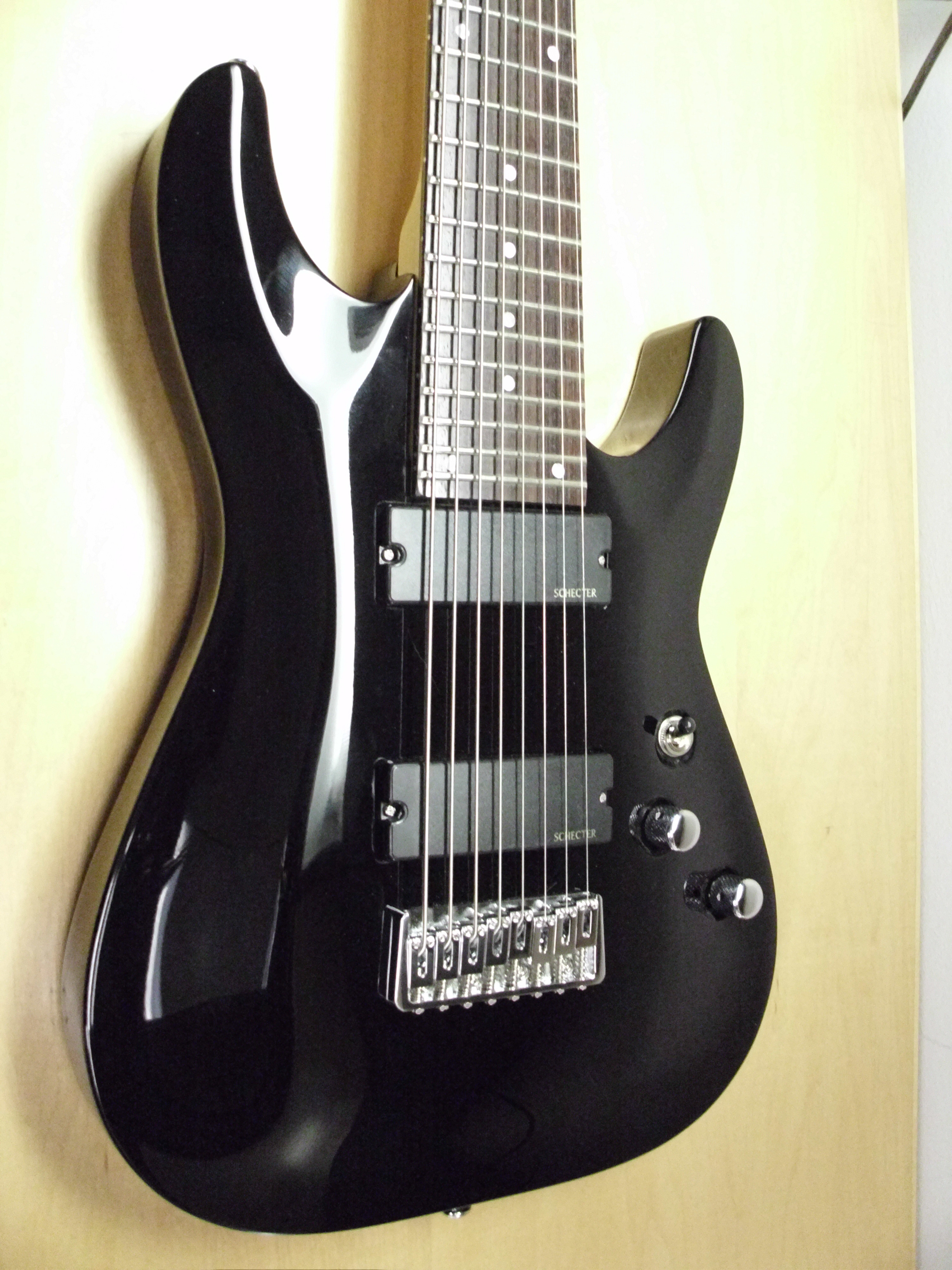
The Schecter Omen 8 string guitar showcasing its fixed bridge and pickup configuration.
In contrast, the Damien Elite 8 features a mahogany body with a quilted maple top, multi-ply binding, and active EMG-808 pickups. The Omen 8’s body is surprisingly contoured, including a belly cut for comfort. While a forearm contour would further enhance ergonomics, the existing contours are a welcome touch. The electronics routing is clean, and the finish is remarkably well-applied for a guitar in this price range.
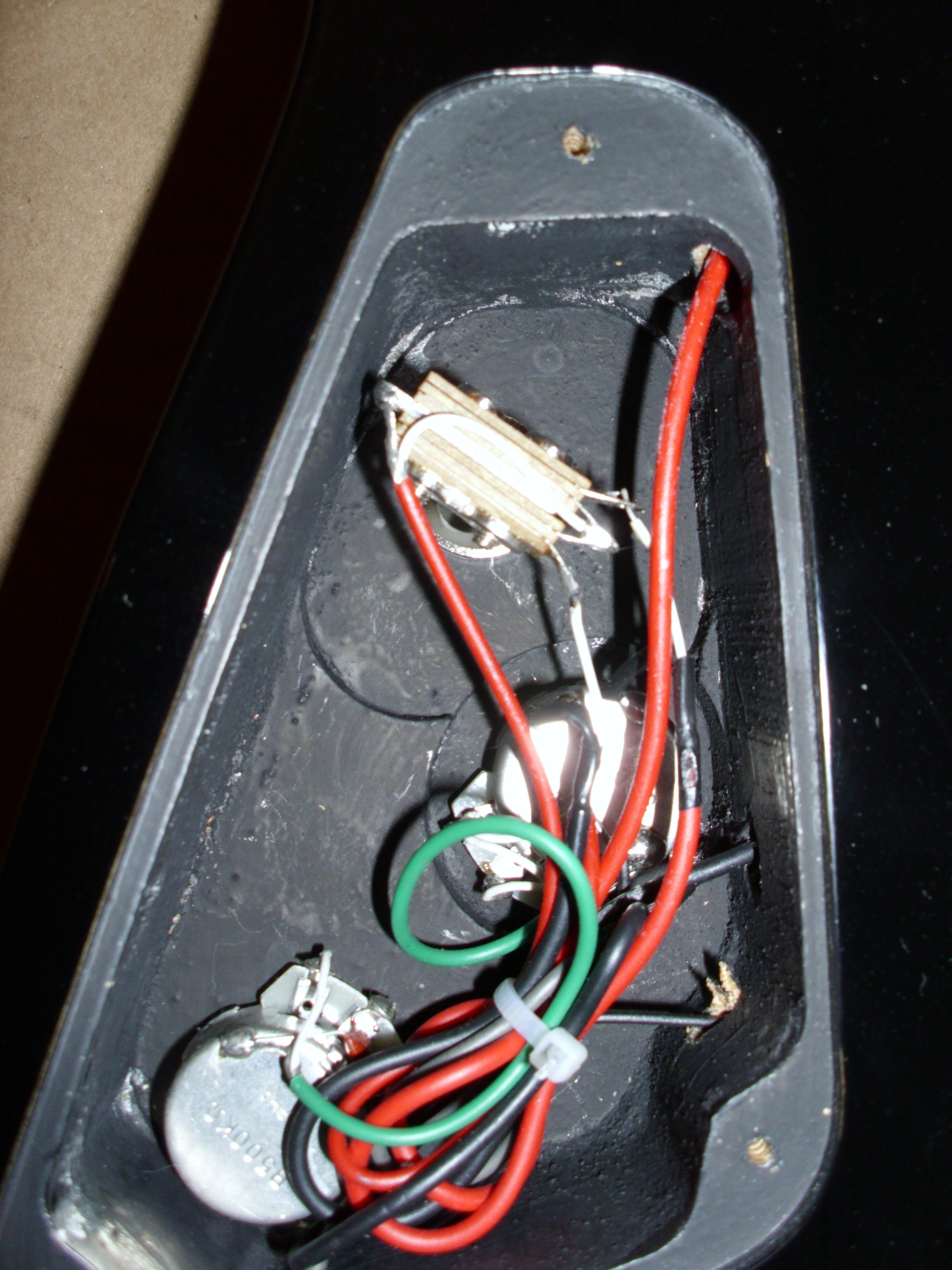
Close-up view of the Schecter Omen 8 string guitar body, highlighting the finish and contours.
The string-through-body bridge design of this Schecter 8 string guitar functions effectively, contributing to sustain. The stock pickups are functional, but they lack a certain punch and clarity. This might be partially attributed to the basswood body – a common characteristic. This is one reason why I personally prefer bolt-on necks over neck-through designs. With a bolt-on neck, you have the flexibility to swap out components if you prefer a different neck or body wood. However, with a neck-through design, you’re essentially committed to the entire instrument. While the stock pickups are usable, I’m not a fan of active pickups in general, so I would likely consider upgrading them even if I had opted for the pricier Damien Elite.
The 24 jumbo-fret maple neck, bolted onto the body, is paired with a rosewood fingerboard and a 26.5″ scale length. This extended scale is crucial for accommodating the lower tunings commonly used on 8 string guitars. While you can tune an 8-string to various configurations, the Omen 8 comes strung with what appears to be D’Addario strings. (Update: Thanks to insights from the sevenstring.org forum, Schecter’s standard 8-string set is .10, .13, .17, .30, .42, .54, .64, .74, facilitating a standard F#-B-E-A-D-G-B-E tuning from low to high). The Schecter tuners are functional, though the Damien Elite upgrades to Grover tuners. The fretboard inlay is a simple dot design, a departure from the more ornate “stained cross” inlays found on the Elite model.
Many online forums discuss “baseball bat necks” on bolt-on Schecters. However, I didn’t find the Omen 8’s neck to be excessively thick. While there is a heel contour to improve access to the upper frets:
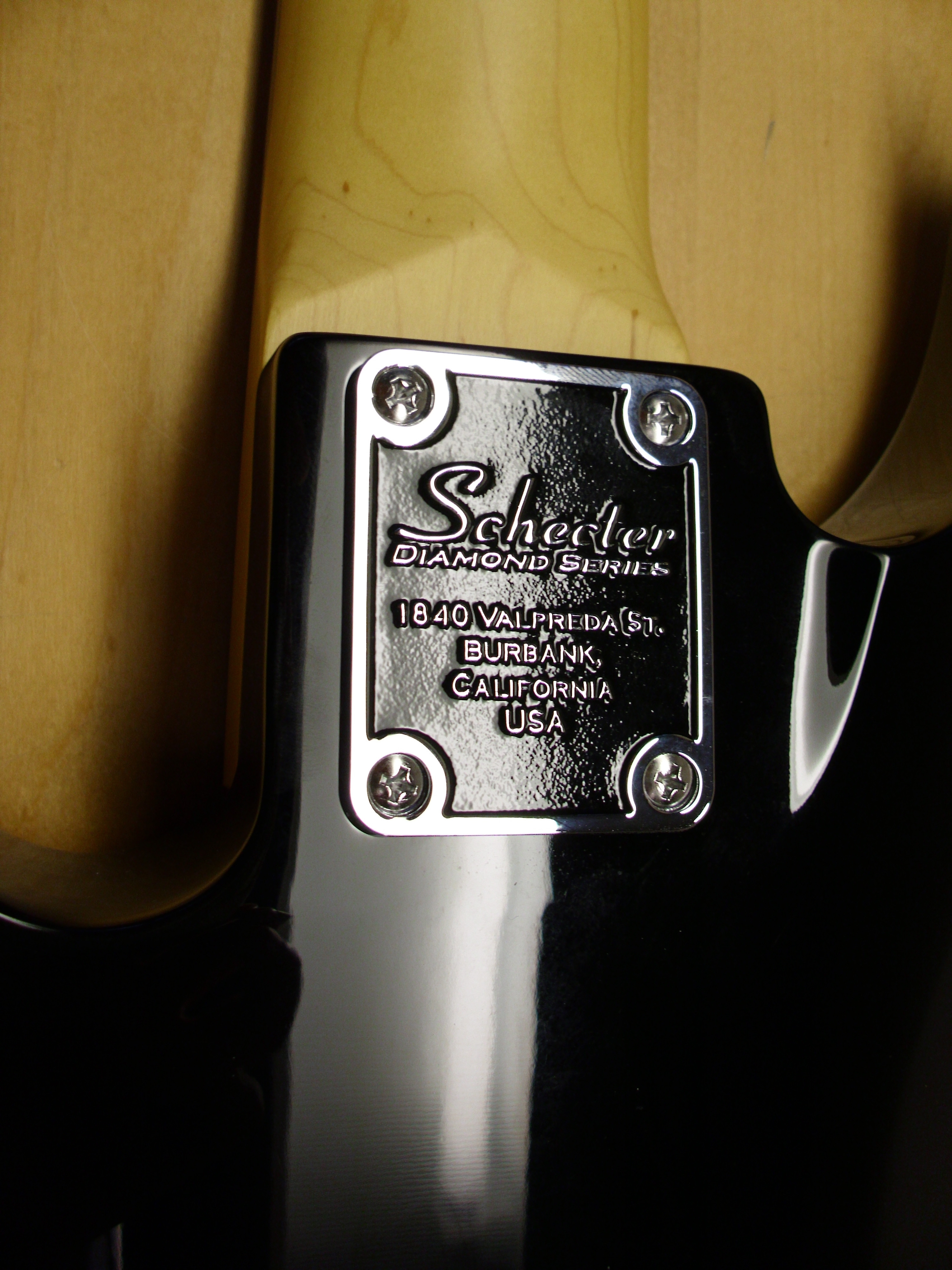
The neck heel contour of the Schecter Omen 8 string guitar, designed for better upper fret access.
The neck joint itself remains somewhat substantial.
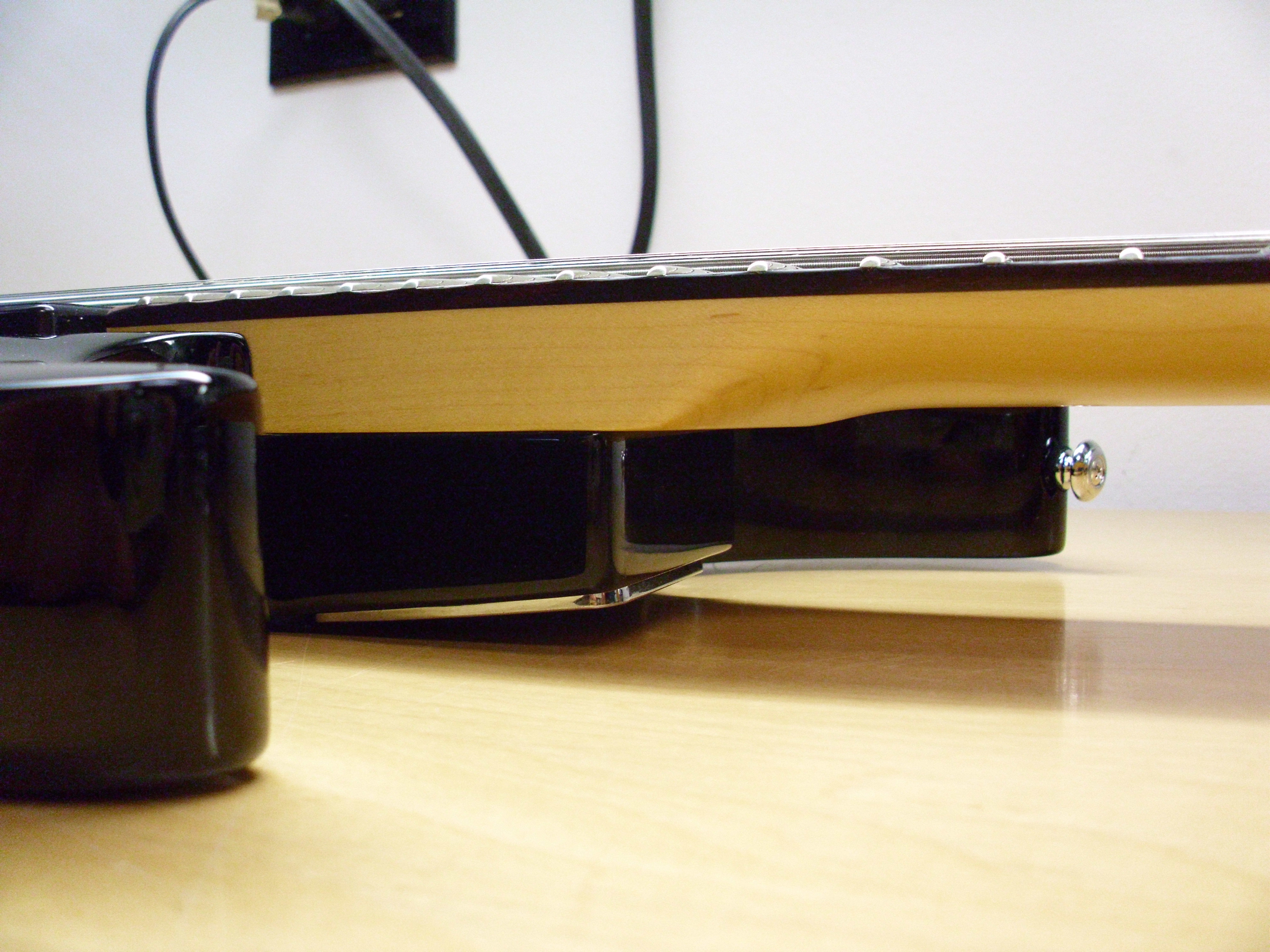
A closer look at the neck joint of the Schecter Omen 8 string guitar, showing its robust construction.
Considering the significant string tension exerted on the neck of an 8 string guitar, this robust joint is understandable. However, it does mean that the highest two frets are somewhat less practical for regular playing, primarily useful for tapping or very high bends.
The initial setup of this Schecter 8 string guitar was decent but required further adjustments. Beyond the F# string intonation being off, the nut action was quite high for several strings.
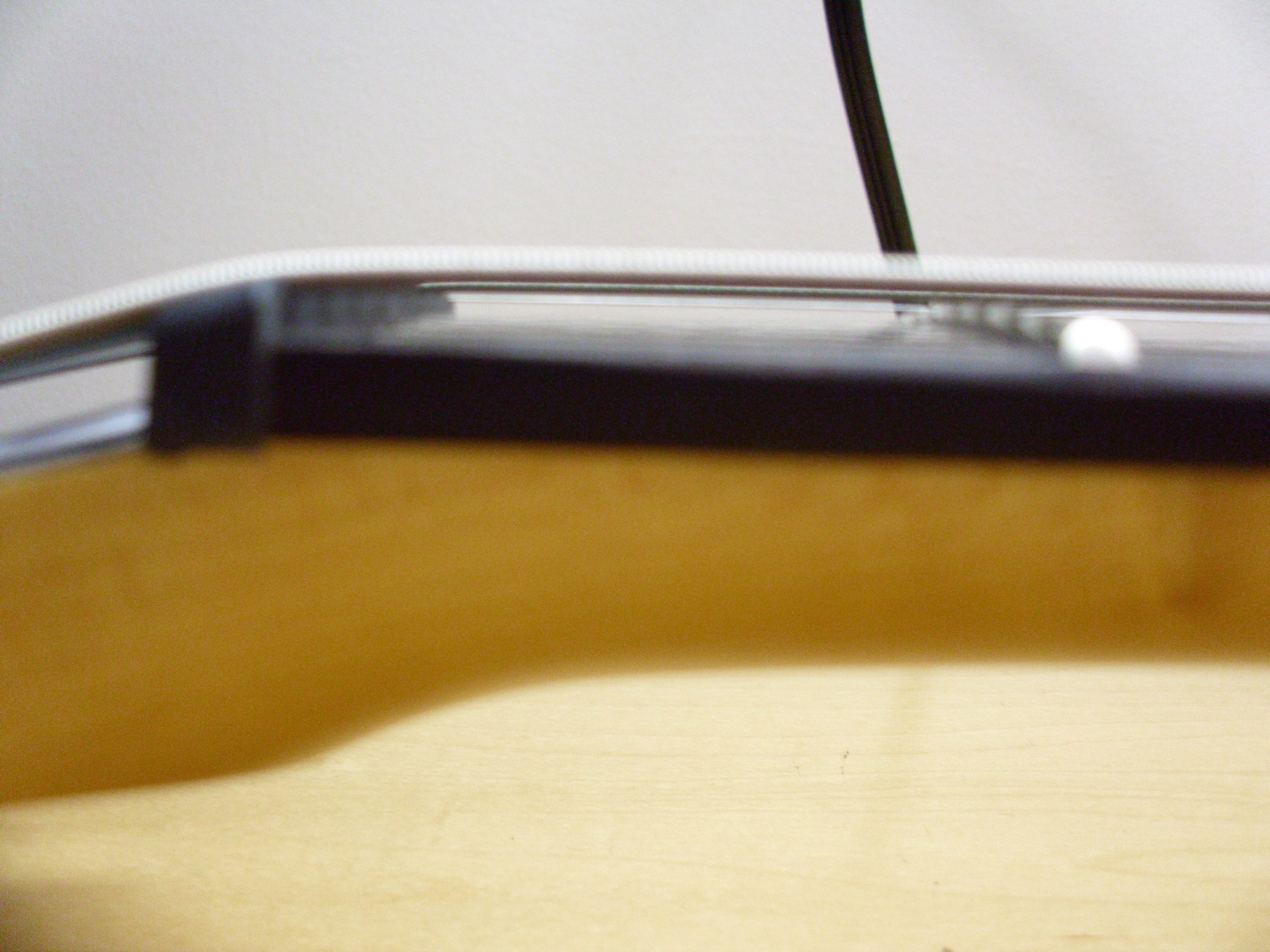
The nut of the Schecter Omen 8 string guitar, showing the string height.
While the lowest string on an 8 string guitar needs ample space to vibrate freely, the nut slots were also high for the E, A, and D strings, especially noticeable in the higher fret positions.
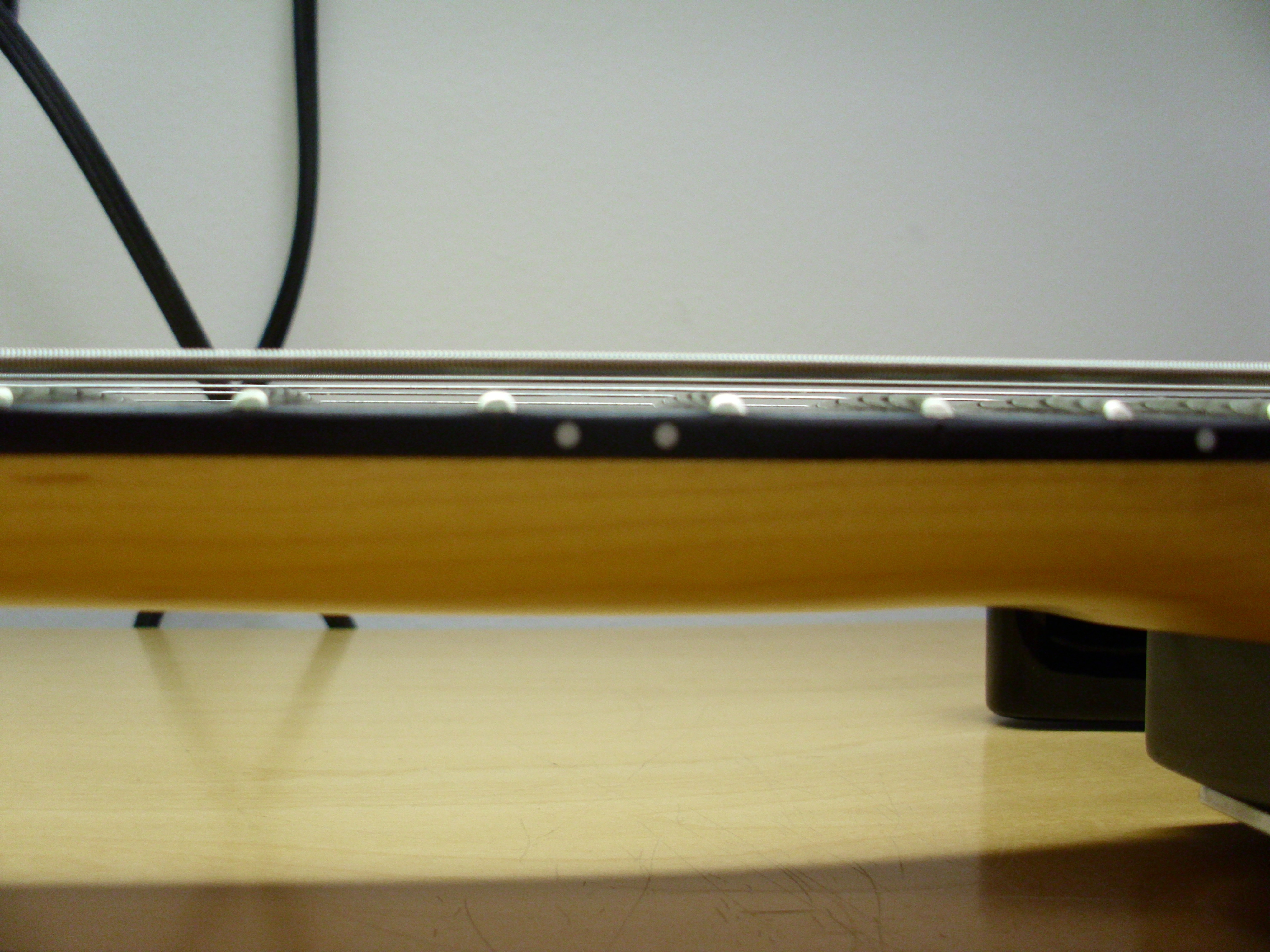
String action at the higher frets of the Schecter Omen 8 string guitar, indicating room for setup improvement.
Schecter Omen 8 String Guitar in Action
Acoustically, the Omen 8 sustains well even without amplification. However, the factory-shipped .074 gauge string on a 26.5″ scale feels too light for the low F#. At that low pitch, the string tends to be flabby and lacks definition on the fretboard. Furthermore, the F# in this register has a somewhat ambiguous timbre, almost caught between a bass and a guitar. Clean tones are achievable and pleasant, but integrating the low F# with distorted tones proved challenging. This could be partly due to the stock pickups. The high-gain tones that work well for single notes tend to become muddy and indistinct when playing chords, requiring careful EQ and gain staging. Switching to a heavier gauge string, perhaps an .080 or higher, would likely improve the low-end tightness. I might explore this option eventually, but for now, I aimed for a more versatile tuning.
Consequently, I opted to eliminate the low F# and explore alternative tunings. Currently, I’m using a (low to high) B-E-A-D-G-C-E-A tuning. This configuration utilizes a standard D’Addario 7-string pack, supplemented with a .007 gauge string for the high A. I also swapped the .059 for a .062 for the low B string, which provides a more comfortable feel and improved tension.
Tech Tips for Schecter 8 String Guitar Players
If you’re considering the high A tuning on your Schecter 8 string guitar, here are a couple of helpful tips:
-
Intonation Adjustments: When changing string gauges or tunings, intonation adjustments are essential. Start by removing the lowest string (in this case, the F#). Before installing the new string, move the saddle forward so its front edge aligns with the saddle of the low B string. Crucially, do not adjust the saddle height screws! You are only adjusting the string length for proper intonation. Since the other strings are already intonated, this method significantly reduces setup time. Leave the highest string saddle (high A) as is and adjust if needed.
-
High String Tuning Stability: When tuning a string up significantly, especially a thinner gauge string to a higher pitch like the high A, tuning stability can be an issue. My recommendation is to tune the string up incrementally towards your target pitch. For example, tune the high string up to F# or G, and let it sit for a few minutes. Tune the other strings. Every 3-5 minutes, attempt to raise the high string another half step, repeating until you reach your desired pitch. Allowing the string to stretch gradually at various points makes it more stable under tension and less prone to snapping or quickly going out of tune.
Playing in this B-E-A-D-G-C-E-A tuning raises the question of how it would perform on a 25.5″ scale guitar. The advantage of a shorter scale for me would be the ability to use heavier gauge strings like .011s or even .012s for the lower six strings, and then tailor the high and low strings accordingly. Heavier gauge strings would likely drive the pickups more effectively, potentially resulting in a richer, fuller tone. However, a shorter scale might compromise the tension of the low B. Every guitar setup involves compromises; it’s simply something to consider.
- Nut Slot Adjustments: Changing string gauges, particularly significantly, may necessitate adjustments to the nut slots. If you’re not experienced with nut work, I strongly advise having a qualified guitar technician perform these adjustments to avoid damaging your instrument.
Final Verdict on the Schecter Omen 8 String Guitar
I consistently find myself impressed by the remarkable value proposition of instruments manufactured in South Korea these days. If the Schecter Omen 8 retails for around $400 on platforms like Amazon (rounding up for simplicity), its production cost in South Korea, including shipping, likely falls in the $150-$200 range – a truly astonishing figure when you consider the instrument you receive.
Be prepared to invest some additional funds in a professional setup immediately after purchase to optimize playability. Further down the line, you may want to budget for pickup upgrades and potentially tuner replacements to further enhance the guitar’s performance. If you prefer active pickups or desire a visually striking figured top, saving an additional $200 for the Damien Elite 8 might be worthwhile. However, apart from the aesthetic top and active pickups, the Omen 8 essentially delivers a similar playing experience for a significantly lower price – approximately one-third less.
I’m still in the process of fully exploring the sonic possibilities of this Schecter 8 string guitar and refining my playing technique for extended range instruments! In the meantime, you can delve deeper and listen to sound samples in my follow-up review here.
If you’re seeking a gig bag for your 8 string guitar, the Gator Viper currently stands out as an excellent value option.
Should you have any questions about the Schecter Omen 8 or extended range guitars in general, please don’t hesitate to contact me at guitar.blueprint@gmail.com!
Happy playing!
-SC

